towing MITSUBISHI GRANDIS 2008 Owner's Manual (in English)
[x] Cancel search | Manufacturer: MITSUBISHI, Model Year: 2008, Model line: GRANDIS, Model: MITSUBISHI GRANDIS 2008Pages: 458, PDF Size: 18.52 MB
Page 50 of 458
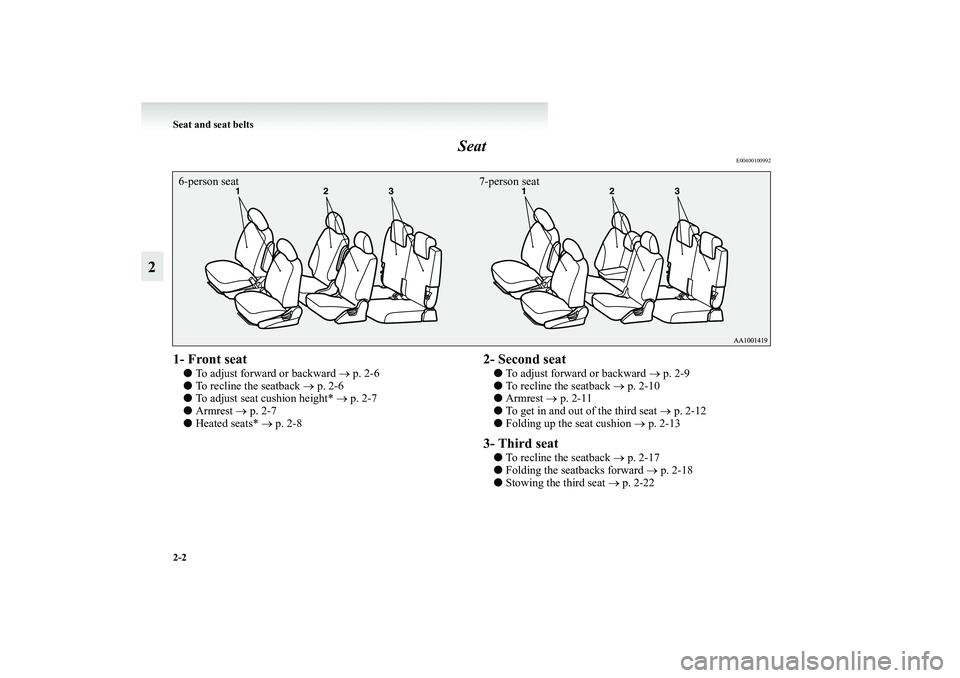
2-2 Seat and seat belts
2Seat
E00400100992
1- Front seat ●To adjust forward or backward → p. 2-6
●To recline the seatback → p. 2-6
●To adjust seat cushion height* → p. 2-7
●Armrest → p. 2-7
●Heated seats* → p. 2-8
2- Second seat●To adjust forward or backward → p. 2-9
●To recline the seatback → p. 2-10
●Armrest → p. 2-11
●To get in and out of the third seat → p. 2-12
●Folding up the seat cushion → p. 2-133- Third seat●To recline the seatback → p. 2-17
●Folding the seatbacks forward → p. 2-18
●Stowing the third seat → p. 2-22
6-person seat 7-person seatBK-XP08E1ENUK.en-uk.book Page 2 Monday, August 13, 2007 2:20 PM
Page 52 of 458
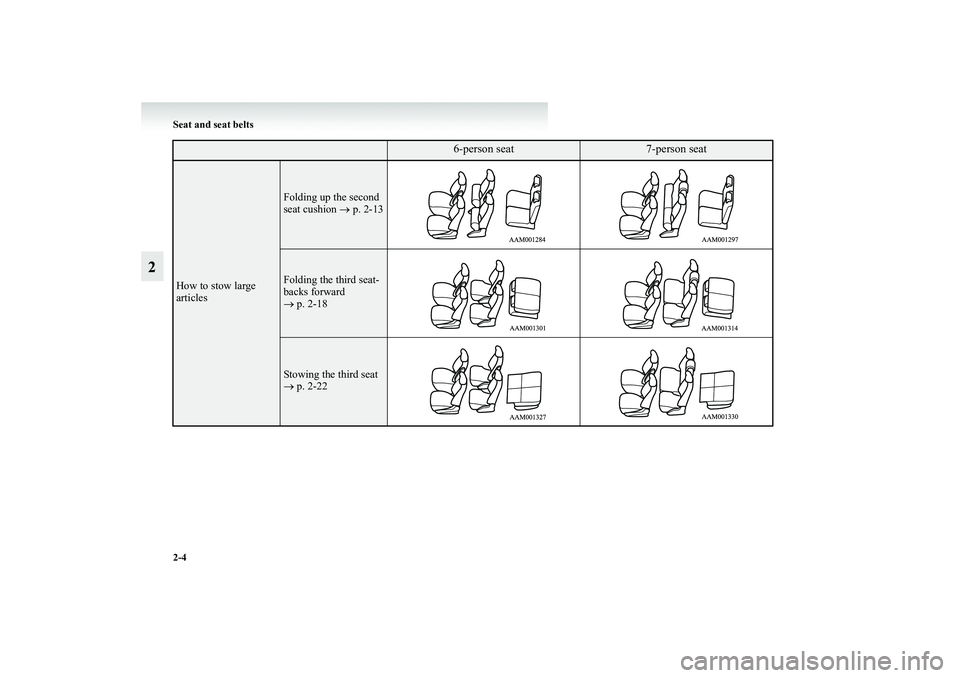
2-4 Seat and seat belts
2
How to stow large
articles
Folding up the second
seat cushion → p. 2-13Folding the third seat-
backs forward
→ p. 2-18Stowing the third seat
→ p. 2-22
6-person seat
7-person seat
BK-XP08E1ENUK.en-uk.book Page 4 Monday, August 13, 2007 2:20 PM
Page 70 of 458
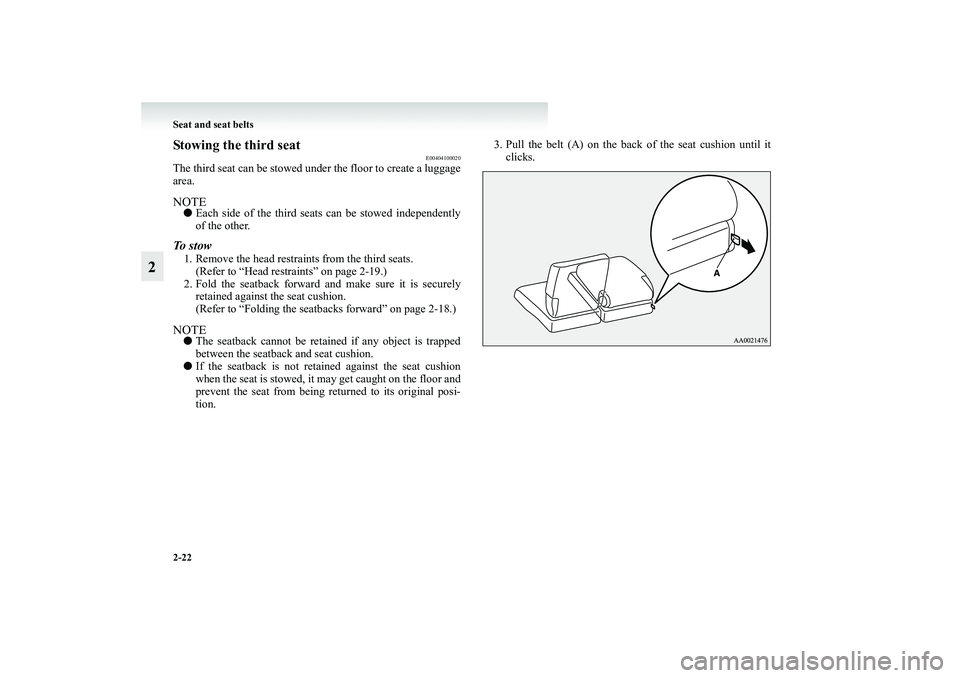
2-22 Seat and seat belts
2
Stowing the third seat
E00404100020
The third seat can be stowed under the floor to create a luggage
area.NOTE●Each side of the third seats can be stowed independently
of the other.To s t o w1. Remove the head restraints from the third seats.
(Refer to “Head restraints” on page 2-19.)
2. Fold the seatback forward and make sure it is securely
retained against the seat cushion.
(Refer to “Folding the seatbacks forward” on page 2-18.)NOTE●The seatback cannot be retained if any object is trapped
between the seatback and seat cushion.
●If the seatback is not retained against the seat cushion
when the seat is stowed, it may get caught on the floor and
prevent the seat from being returned to its original posi-
tion.3. Pull the belt (A) on the back of the seat cushion until it
clicks.
BK-XP08E1ENUK.en-uk.book Page 22 Monday, August 13, 2007 2:20 PM
Page 71 of 458
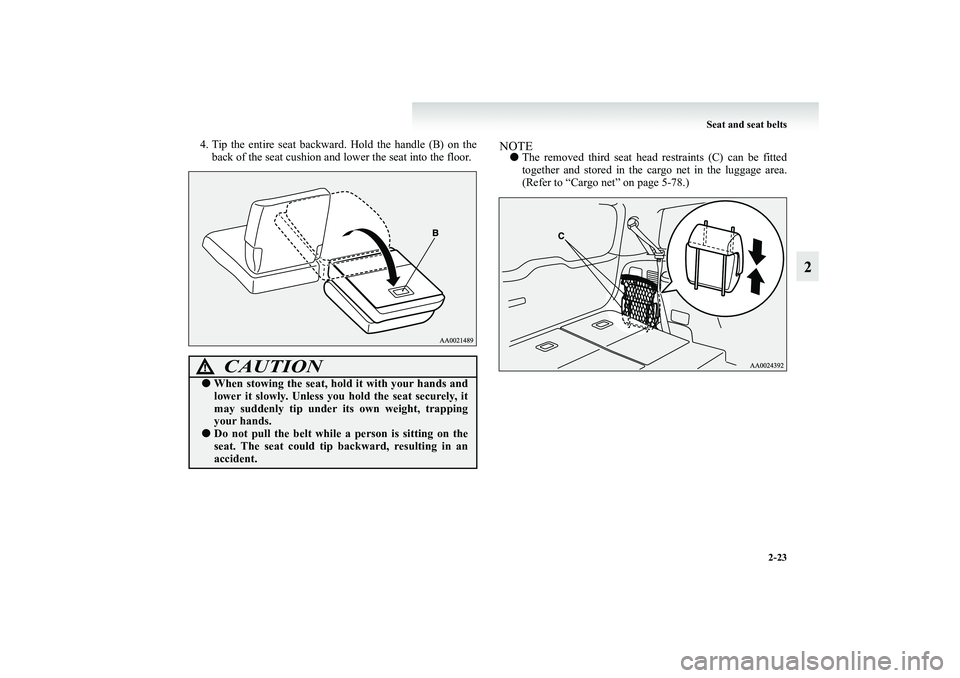
Seat and seat belts
2-23
2
4. Tip the entire seat backward. Hold the handle (B) on the
back of the seat cushion and lower the seat into the floor.
NOTE●The removed third seat head restraints (C) can be fitted
together and stored in the cargo net in the luggage area.
(Refer to “Cargo net” on page 5-78.)
CAUTION
!●When stowing the seat, hold it with your hands and
lower it slowly. Unless you hold the seat securely, it
may suddenly tip under its own weight, trapping
your hands.●Do not pull the belt while a person is sitting on the
seat. The seat could tip backward, resulting in an
accident.
BK-XP08E1ENUK.en-uk.book Page 23 Monday, August 13, 2007 2:20 PM
Page 137 of 458
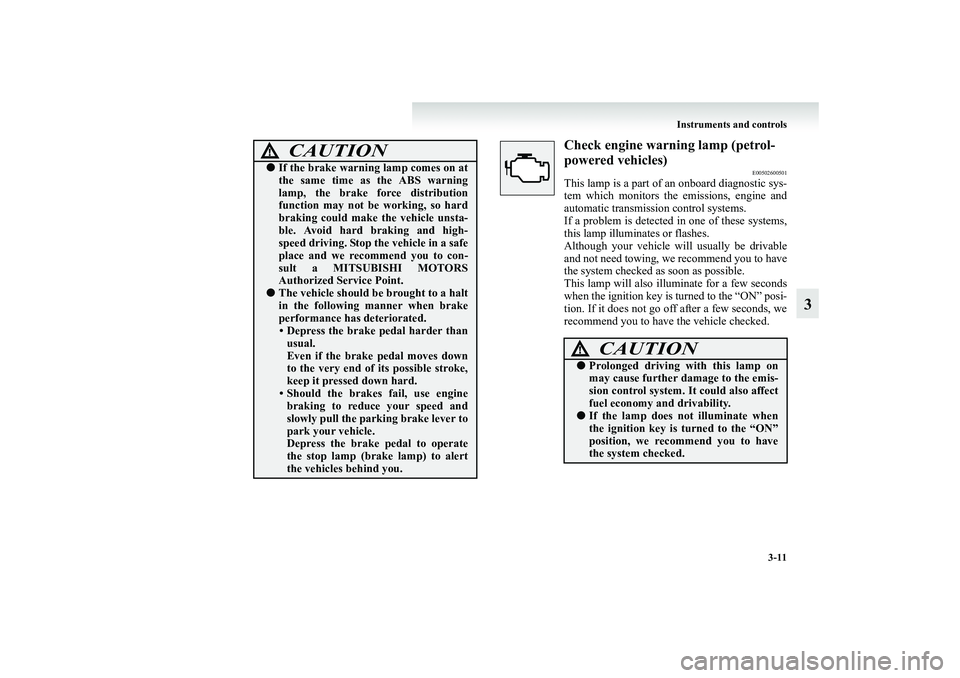
Instruments and controls
3-11
3
Check engine warning lamp (petrol-
powered vehicles)
E00502600501
This lamp is a part of an onboard diagnostic sys-
tem which monitors the emissions, engine and
automatic transmission control systems.
If a problem is detected in one of these systems,
this lamp illuminates or flashes.
Although your vehicle will usually be drivable
and not need towing, we recommend you to have
the system checked as soon as possible.
This lamp will also illuminate for a few seconds
when the ignition key is turned to the “ON” posi-
tion. If it does not go off after a few seconds, we
recommend you to have the vehicle checked.
●If the brake warning lamp comes on at
the same time as the ABS warning
lamp, the brake force distribution
function may not be working, so hard
braking could make the vehicle unsta-
ble. Avoid hard braking and high-
speed driving. Stop the vehicle in a safe
place and we recommend you to con-
sult a MITSUBISHI MOTORS
Authorized Service Point.●The vehicle should be brought to a halt
in the following manner when brake
performance has deteriorated.
• Depress the brake pedal harder than
usual.
Even if the brake pedal moves down
to the very end of its possible stroke,
keep it pressed down hard.
• Should the brakes fail, use engine
braking to reduce your speed and
slowly pull the parking brake lever to
park your vehicle.
Depress the brake pedal to operate
the stop lamp (brake lamp) to alert
the vehicles behind you.CAUTION
!
CAUTION
!●Prolonged driving with this lamp on
may cause further damage to the emis-
sion control system. It could also affect
fuel economy and drivability.●If the lamp does not illuminate when
the ignition key is turned to the “ON”
position, we recommend you to have
the system checked.
BK-XP08E1ENUK.en-uk.book Page 11 Monday, August 13, 2007 2:20 PM
Page 138 of 458
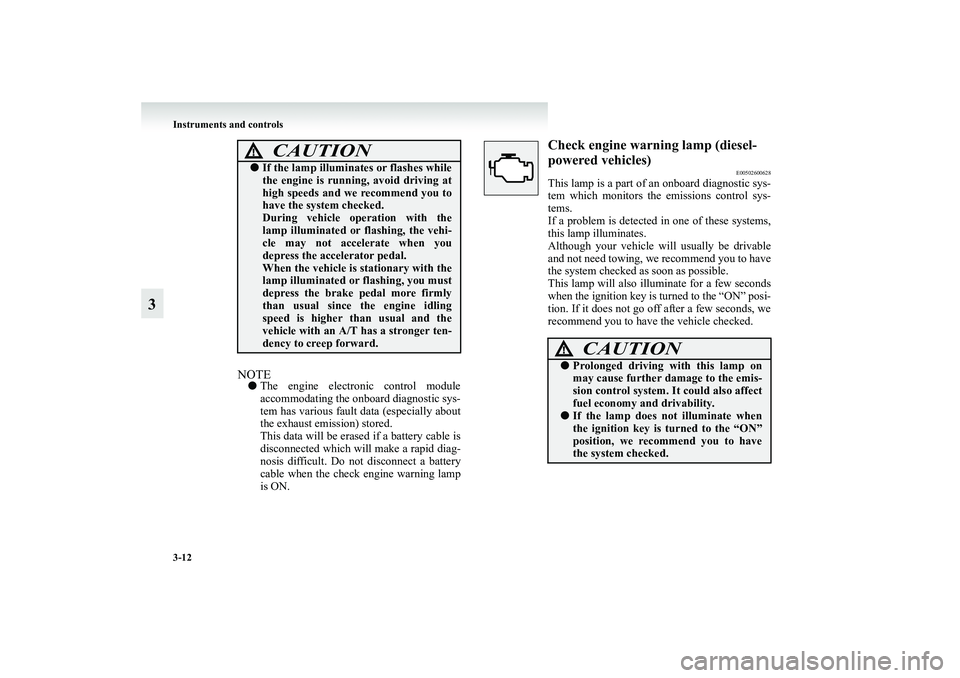
3-12 Instruments and controls
3
NOTE●The engine electronic control module
accommodating the onboard diagnostic sys-
tem has various fault data (especially about
the exhaust emission) stored.
This data will be erased if a battery cable is
disconnected which will make a rapid diag-
nosis difficult. Do not disconnect a battery
cable when the check engine warning lamp
is ON.
Check engine warning lamp (diesel-
powered vehicles)
E00502600628
This lamp is a part of an onboard diagnostic sys-
tem which monitors the emissions control sys-
tems.
If a problem is detected in one of these systems,
this lamp illuminates.
Although your vehicle will usually be drivable
and not need towing, we recommend you to have
the system checked as soon as possible.
This lamp will also illuminate for a few seconds
when the ignition key is turned to the “ON” posi-
tion. If it does not go off after a few seconds, we
recommend you to have the vehicle checked.
●If the lamp illuminates or flashes while
the engine is running, avoid driving at
high speeds and we recommend you to
have the system checked.
During vehicle operation with the
lamp illuminated or flashing, the vehi-
cle may not accelerate when you
depress the accelerator pedal.
When the vehicle is stationary with the
lamp illuminated or flashing, you must
depress the brake pedal more firmly
than usual since the engine idling
speed is higher than usual and the
vehicle with an A/T has a stronger ten-
dency to creep forward.
CAUTION
!
CAUTION
!●Prolonged driving with this lamp on
may cause further damage to the emis-
sion control system. It could also affect
fuel economy and drivability.●If the lamp does not illuminate when
the ignition key is turned to the “ON”
position, we recommend you to have
the system checked.
BK-XP08E1ENUK.en-uk.book Page 12 Monday, August 13, 2007 2:20 PM
Page 173 of 458
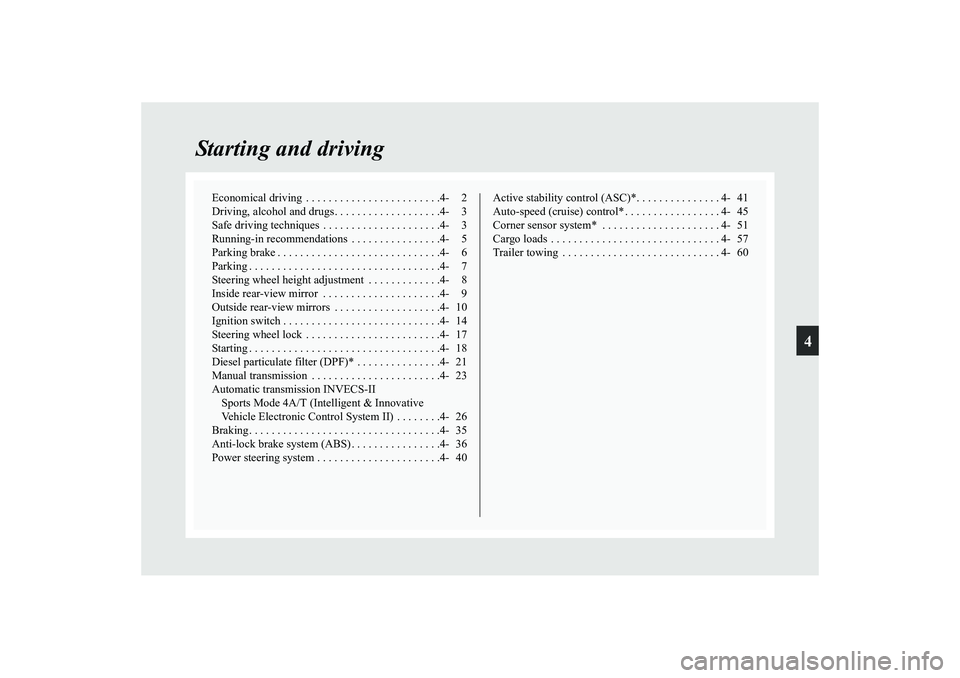
4
Starting and driving
Economical driving . . . . . . . . . . . . . . . . . . . . . . . .4- 2
Driving, alcohol and drugs. . . . . . . . . . . . . . . . . . .4- 3
Safe driving techniques . . . . . . . . . . . . . . . . . . . . .4- 3
Running-in recommendations . . . . . . . . . . . . . . . .4- 5
Parking brake . . . . . . . . . . . . . . . . . . . . . . . . . . . . .4- 6
Parking . . . . . . . . . . . . . . . . . . . . . . . . . . . . . . . . . .4- 7
Steering wheel height adjustment . . . . . . . . . . . . .4- 8
Inside rear-view mirror . . . . . . . . . . . . . . . . . . . . .4- 9
Outside rear-view mirrors . . . . . . . . . . . . . . . . . . .4- 10
Ignition switch . . . . . . . . . . . . . . . . . . . . . . . . . . . .4- 14
Steering wheel lock . . . . . . . . . . . . . . . . . . . . . . . .4- 17
Starting . . . . . . . . . . . . . . . . . . . . . . . . . . . . . . . . . .4- 18
Diesel particulate filter (DPF)* . . . . . . . . . . . . . . .4- 21
Manual transmission . . . . . . . . . . . . . . . . . . . . . . .4- 23
Automatic transmission INVECS-II
Sports Mode 4A/T (Intelligent & Innovative
Vehicle Electronic Control System II) . . . . . . . .4- 26
Braking. . . . . . . . . . . . . . . . . . . . . . . . . . . . . . . . . .4- 35
Anti-lock brake system (ABS) . . . . . . . . . . . . . . . .4- 36
Power steering system . . . . . . . . . . . . . . . . . . . . . .4- 40Active stability control (ASC)*. . . . . . . . . . . . . . . 4- 41
Auto-speed (cruise) control* . . . . . . . . . . . . . . . . . 4- 45
Corner sensor system* . . . . . . . . . . . . . . . . . . . . . 4- 51
Cargo loads . . . . . . . . . . . . . . . . . . . . . . . . . . . . . . 4- 57
Trailer towing . . . . . . . . . . . . . . . . . . . . . . . . . . . . 4- 60
BK-XP08E1ENUK.en-uk.book Page 1 Monday, August 13, 2007 2:20 PM
Page 177 of 458
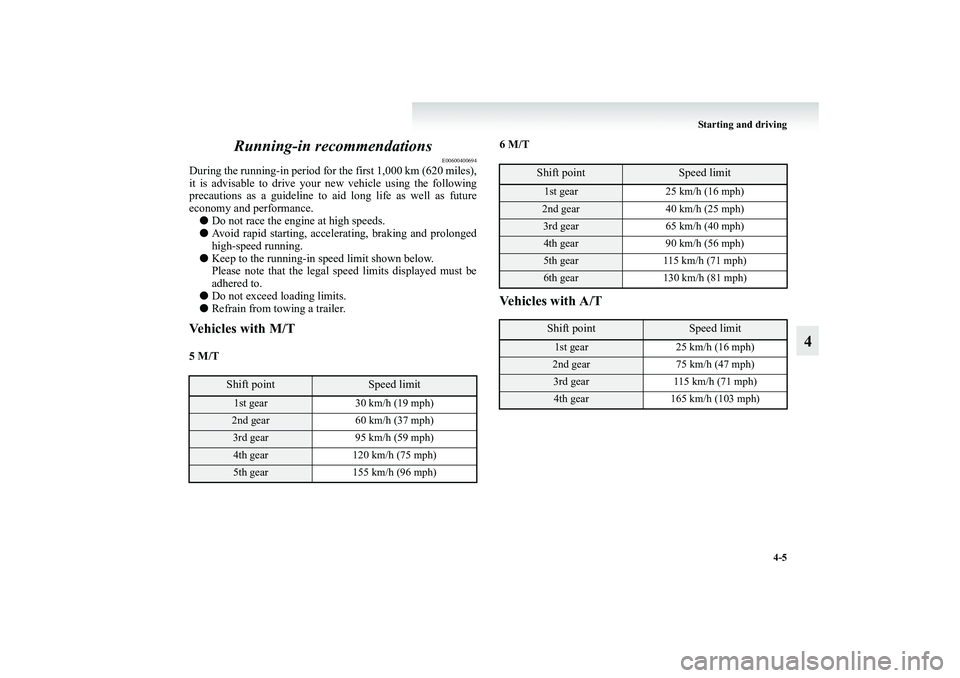
Starting and driving
4-5
4 Running-in recommendations
E00600400694
During the running-in period for the first 1,000 km (620 miles),
it is advisable to drive your new vehicle using the following
precautions as a guideline to aid long life as well as future
economy and performance.
●Do not race the engine at high speeds.
●Avoid rapid starting, accelerating, braking and prolonged
high-speed running.
●Keep to the running-in speed limit shown below.
Please note that the legal speed limits displayed must be
adhered to.
●Do not exceed loading limits.
●Refrain from towing a trailer.Vehicles with M/T5 M/T
6 M/T
Vehicles with A/T
Shift point
Speed limit
1st gear 30 km/h (19 mph)2nd gear 60 km/h (37 mph)3rd gear 95 km/h (59 mph)4th gear 120 km/h (75 mph)5th gear 155 km/h (96 mph)
Shift point
Speed limit
1st gear 25 km/h (16 mph)2nd gear 40 km/h (25 mph)3rd gear 65 km/h (40 mph)4th gear 90 km/h (56 mph)5th gear 115 km/h (71 mph)6th gear 130 km/h (81 mph)Shift point
Speed limit
1st gear 25 km/h (16 mph)2nd gear 75 km/h (47 mph)3rd gear 115 km/h (71 mph)4th gear 165 km/h (103 mph)
BK-XP08E1ENUK.en-uk.book Page 5 Monday, August 13, 2007 2:20 PM
Page 212 of 458
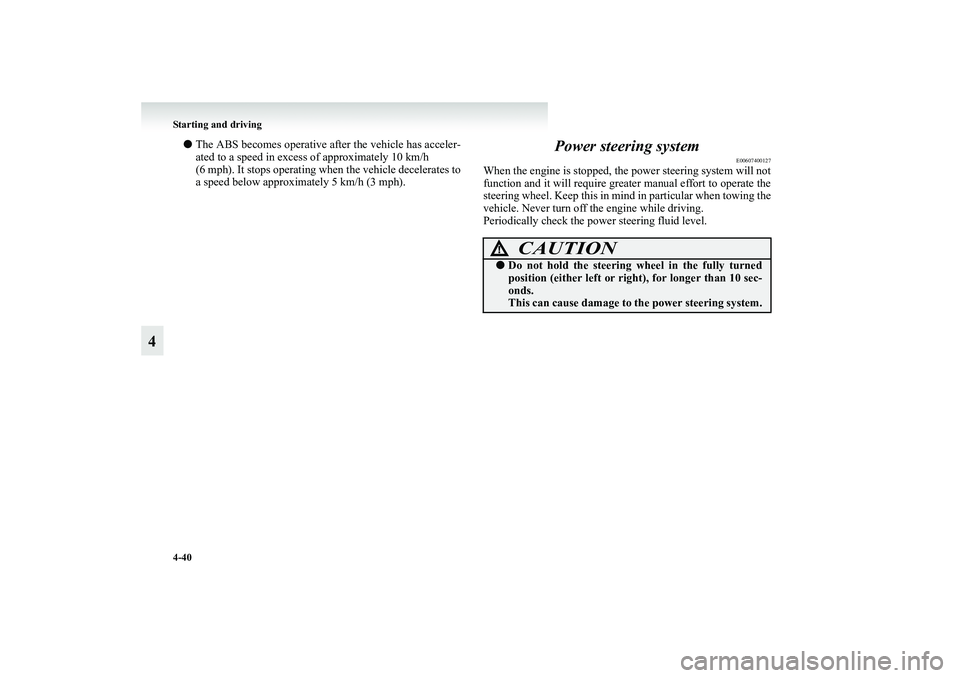
4-40 Starting and driving
4
●The ABS becomes operative after the vehicle has acceler-
ated to a speed in excess of approximately 10 km/h
(6 mph). It stops operating when the vehicle decelerates to
a speed below approximately 5 km/h (3 mph).
Power steering system
E00607400127
When the engine is stopped, the power steering system will not
function and it will require greater manual effort to operate the
steering wheel. Keep this in mind in particular when towing the
vehicle. Never turn off the engine while driving.
Periodically check the power steering fluid level.
CAUTION
!●Do not hold the steering wheel in the fully turned
position (either left or right), for longer than 10 sec-
onds.
This can cause damage to the power steering system.
BK-XP08E1ENUK.en-uk.book Page 40 Monday, August 13, 2007 2:20 PM
Page 216 of 458

4-44 Starting and driving
4
CAUTION
!●When the indication lamp blinks, ASC is operat-
ing, which means that the road is slippery or that
your vehicle’s wheels are slipping excessively. If this
happens, drive slower with less accelerator input.●If a malfunction occurs in the device, the and
indication lamps will continuously illuminate. Park
your vehicle in a safe place and stop the engine.
Then, start the engine again and check whether the
and indication lamps go out.
If the and indication lamps remain on even
after your vehicle is driven a short distance after
starting the engine, we recommend you to consult a
MITSUBISHI MOTORS Authorized Service Point.●If continuous brake control (on a slippery surface,
for example) causes the temperature of the braking
system to increase excessively, the traction control
function (working by controlling the brake on each
wheel) will be suspended to protect the braking sys-
tem. [The traction control function (working by con-
trolling the engine output) will operate. Normal
operation of the vehicle will not be affected.] At this
time, the indication lamp will blink to inform the
driver that the traction control function (working by
controlling the brake on each wheel) is suspended. If
the vehicle is stopped and the indication lamp
goes off, the traction control function (working by
controlling the brake on each wheel) will start oper-
ating again.
CAUTION
!●If the vehicle is towed with the ignition switch in the
“ON” position and only the front wheels or only the
rear wheels raised off the ground, the traction con-
trol function may operate, resulting in an accident.
When towing the vehicle with the front wheels
raised, keep the ignition switch in the “LOCK” or
“ACC” position. When towing the vehicle with the
rear wheels raised, keep the ignition switch in the
“ACC” position.
Refer to “Towing” on page 6-28.
BK-XP08E1ENUK.en-uk.book Page 44 Monday, August 13, 2007 2:20 PM